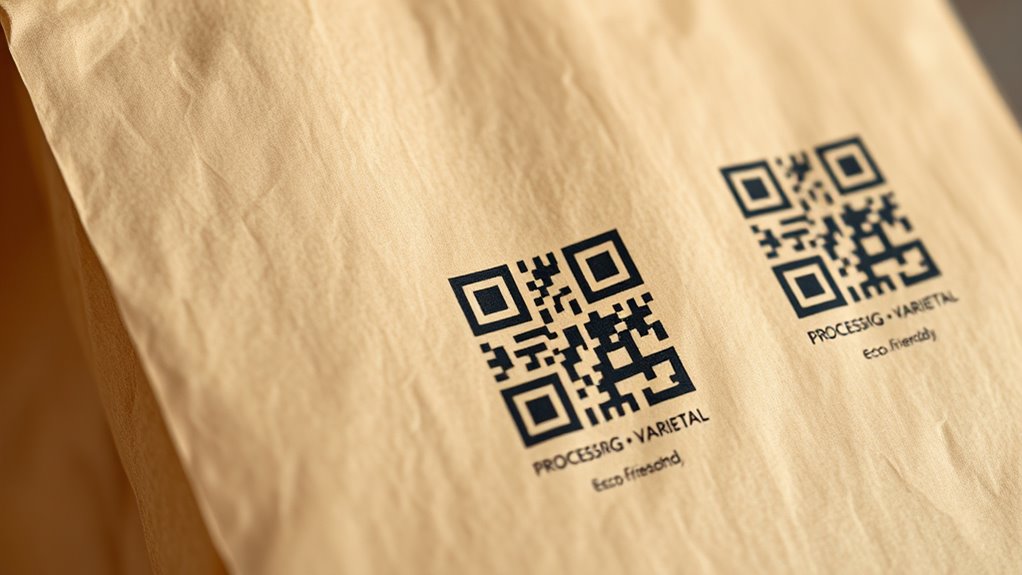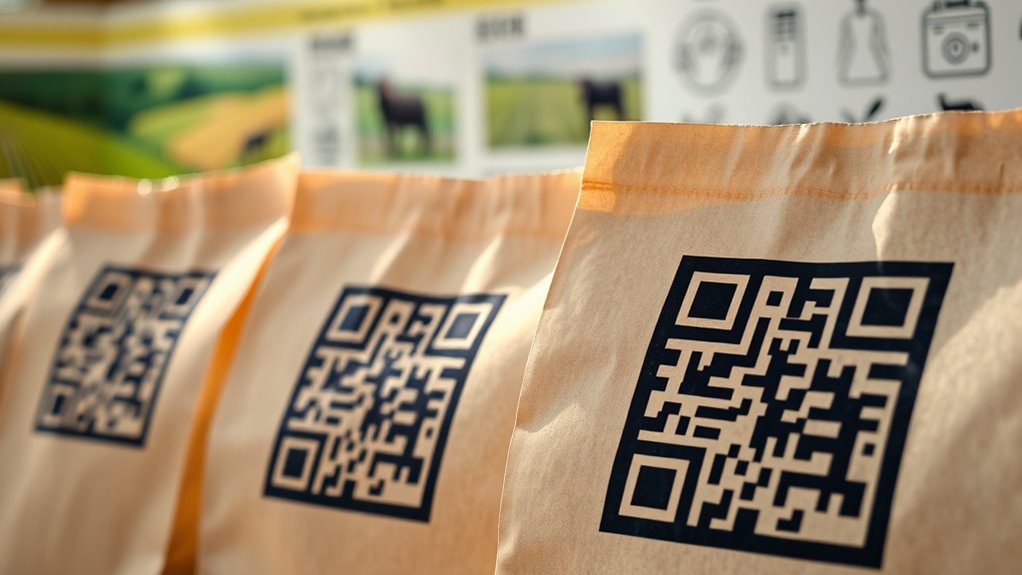To decode processing, varietal, and farm data from QR codes on bags, scan the code with your smartphone or a QR code reader app. The information linked to the code reveals details about how the product was processed, its specific crop variety, and where it came from. Often, this data is encrypted or linked to a website, so exploring further can give you a clearer understanding of the product’s origin and quality.
Key Takeaways
- Use a smartphone or QR code scanner app to scan the code and access embedded product information.
- The decoded data typically includes processing methods, crop varieties, and farm origin details.
- Look for links or encoded text in the QR code that lead to detailed information or product records.
- Some QR codes may require authorized access or encryption to view sensitive processing or farm data.
- Cross-reference the decoded information with product labels or official sources for verification.
Understanding QR Codes and Their Functionality

QR codes are a type of two-dimensional barcode that quickly store and share information. They work by encoding data through a specific QR code design, which allows for efficient scanning and retrieval. When you scan a QR code, the device deciphers the pattern, revealing the embedded data. This process often involves digital encryption, ensuring that sensitive information stays protected during transmission. The design of the QR code, including its size, error correction level, and data capacity, influences how easily it can be scanned and read. Additionally, Hyundai Tuning techniques can be used to optimize QR code readability on different surfaces and materials. By understanding how QR codes function, you can better appreciate their role in linking physical products, like bags, to digital information, streamlining processes from authentication to data sharing.
Common Data Embedded in Product Labels

Have you ever wondered what information is hidden behind the codes on product labels? Barcode scanning reveals a variety of essential data designed to inform consumers and streamline supply chains. Commonly embedded details include product origin, batch number, expiration date, and farm data. Label design plays a critical role in how this information is organized and accessible. Here’s an example of typical embedded data:
| Data Type | Description | Example |
|---|---|---|
| Farm Location | Farm where product was grown | “Farm XYZ, CA” |
| Processing Method | How product was processed | “Washed, Packaged” |
| Varietal Info | Grape or crop variety | “Cabernet Sauvignon” |
| Harvest Date | When harvested | “2024-05-01” |
| Barcodes | Unique product identifiers | UPC or QR code |
This data helps guarantee transparency and quality. Additionally, understanding the processing methods used can inform consumers about the level of handling and potential additives involved.
Deciphering Processing Method Information

Deciphering processing method information from product labels reveals essential details about how the item was prepared, ensuring transparency and quality assurance. QR codes often encode processing data using specific barcode symbology, which helps identify whether the product was roasted, dried, fermented, or processed via other methods. This information can be protected through data encryption, safeguarding sensitive processing details from tampering. When you scan the QR code, you’ll see a clear breakdown of the processing steps, giving you insight into how the product was handled before reaching you. Understanding these details allows you to make informed choices and trust the quality standards behind each item. Additionally, color accuracy plays a role in how clearly the decoding information is displayed on screens, enhancing the user experience. By decoding this information, you gain confidence in the product’s authenticity and processing integrity.
Identifying Varietal and Crop Details

Identifying varietal and crop details from a product label provides critical information about the specific type of plant or bean used in your item. You can often find this data through QR codes that link to detailed records, including genetic markers associated with the crop. These markers help distinguish different varieties, ensuring you know exactly what you’re getting. By understanding crop origins, you gain insights into the plant’s lineage and cultivation history, which can influence flavor, quality, and sustainability. When you scan the QR code, look for information on the varietal name or specific cultivar. This data not only helps you make informed choices but also supports transparency in the supply chain. Accurate identification of crop details empowers you to select products that align with your preferences and values. Additionally, understanding the cultural impact of technology on artistic expression can deepen your appreciation of the stories behind your products.
Tracing Farm Origins and Supply Chain Transparency

By scanning QR codes on bags, you can directly access detailed information about the farm where the product was grown and see the entire supply chain journey. This transparency helps you verify that sustainable farming practices are in place, ensuring environmental and social responsibility. It also enhances supply chain security by providing real-time data, reducing the risk of fraud or contamination. With this technology, you gain insights into each step, from planting to processing, fostering trust in the product’s origin. Knowing the farm’s location and farming methods allows you to support ethical and eco-friendly practices. Signs of spoilage can indicate issues with freshness or handling, emphasizing the importance of traceability. Overall, QR codes empower you to make informed choices, promoting transparency and accountability across the entire supply chain.
Frequently Asked Questions
How Secure Are the Data Stored in QR Codes on Bags?
You might wonder how secure the data in QR codes on bags really is. Typically, these codes use data encryption to protect sensitive info, making it harder for unauthorized people to access it. Plus, access control measures ensure only approved users can decode and view the data. While no system is completely foolproof, combining encryption with strict access controls markedly enhances the security of the information stored in QR codes.
Can Consumers Update or Modify QR Code Information After Printing?
You might wonder if you can update or modify QR code information after printing. Generally, QR codes are static, meaning their data is fixed and can’t be changed once printed. However, some systems use editable information through dynamic QR codes, allowing consumer modifications or updates. Keep in mind, if the QR code is static, any changes require printing a new code. Always verify if the QR code supports editable information before relying on it.
Are QR Codes Standardized Across Different Agricultural Products?
You wonder if QR codes are standardized across different agricultural products. Standardization challenges exist because various regions and industries adopt different formats, creating inconsistencies. International standards aim to unify these codes, but implementation varies widely. This leads to confusion, complicates scanning, and hampers data sharing. To improve, industry stakeholders must collaborate, adopt common standards, and guarantee compatibility, so QR codes become reliable tools for traceability and transparency across global agricultural markets.
What Technologies Are Used to Generate and Read These QR Codes?
You use barcode scanning and image recognition technologies to generate and read QR codes. When creating QR codes, specialized software encodes data into a visual pattern, which can be printed or embedded on bags. To read them, you use devices with cameras and barcode scanners that interpret the pattern, converting it back into usable data. This seamless process guarantees quick, accurate access to processing, varietal, and farm information.
How Do QR Codes Accommodate Language and Accessibility Differences?
Imagine opening essential farm data with just a scan—yet, how does that work across languages and abilities? QR codes support multilingual access by embedding language options or directing you to translated content. Accessibility features like audio descriptions or high-contrast options guarantee everyone can understand the data. This seamless integration makes crucial information accessible to all, regardless of language barriers or physical limitations—changing the way we connect with agricultural data.
Conclusion
So, next time you scan a bag’s QR code, remember it’s not just a fancy barcode—it’s your personal detective into the world of farm secrets, processing quirks, and varietal mysteries. Who knew a tiny square could hold such power? So go ahead, decode away, and impress your friends with your newfound knowledge. Just don’t be too surprised if that bag reveals more than you bargained for—welcome to the wild, wonderful world of supply chain transparency!









